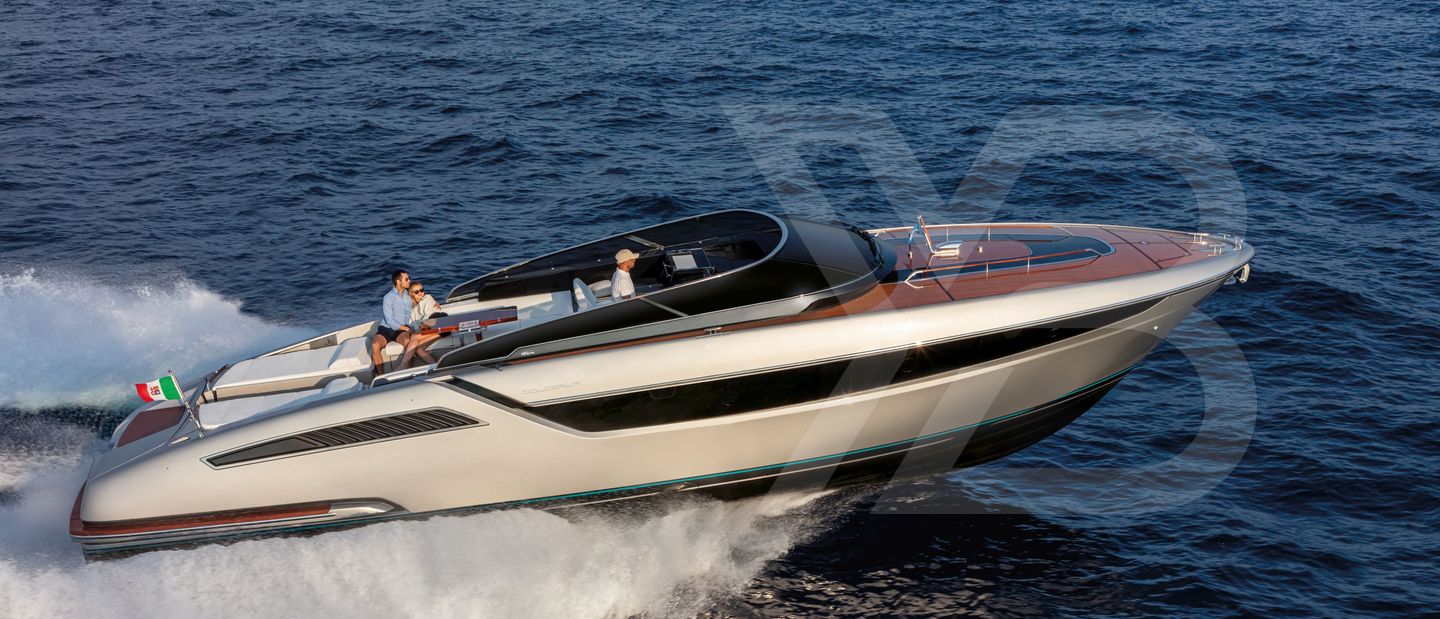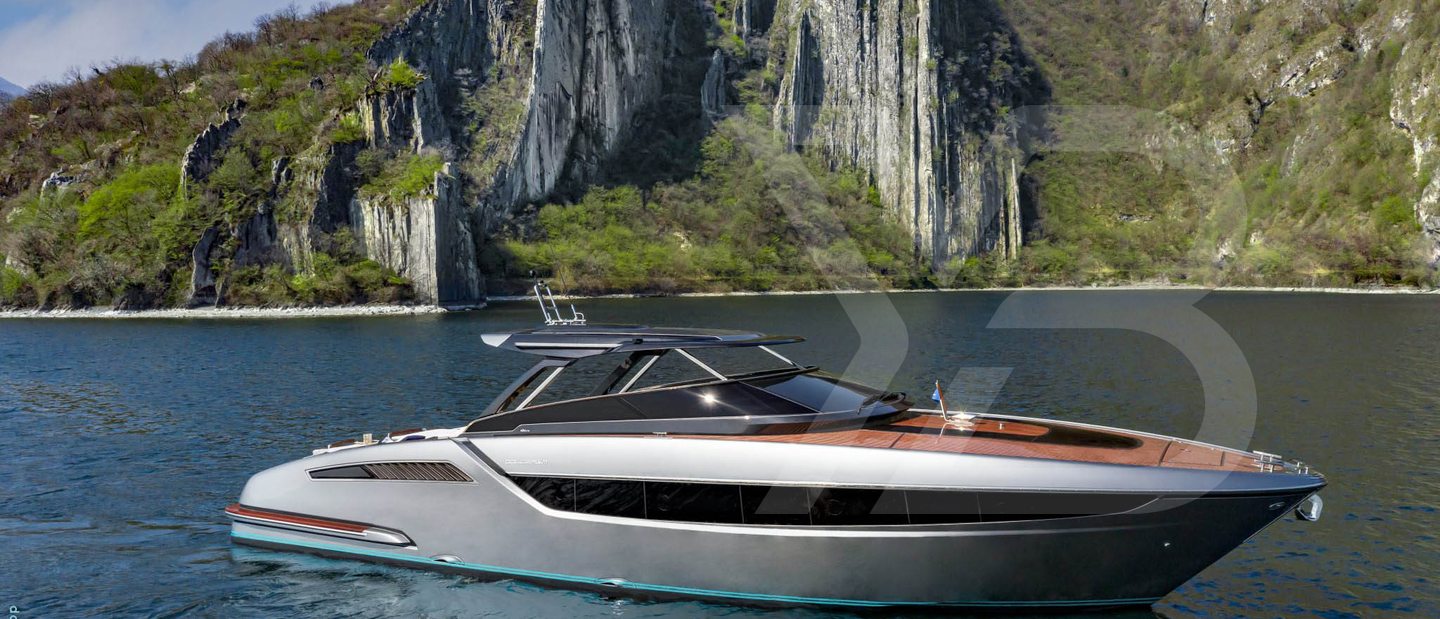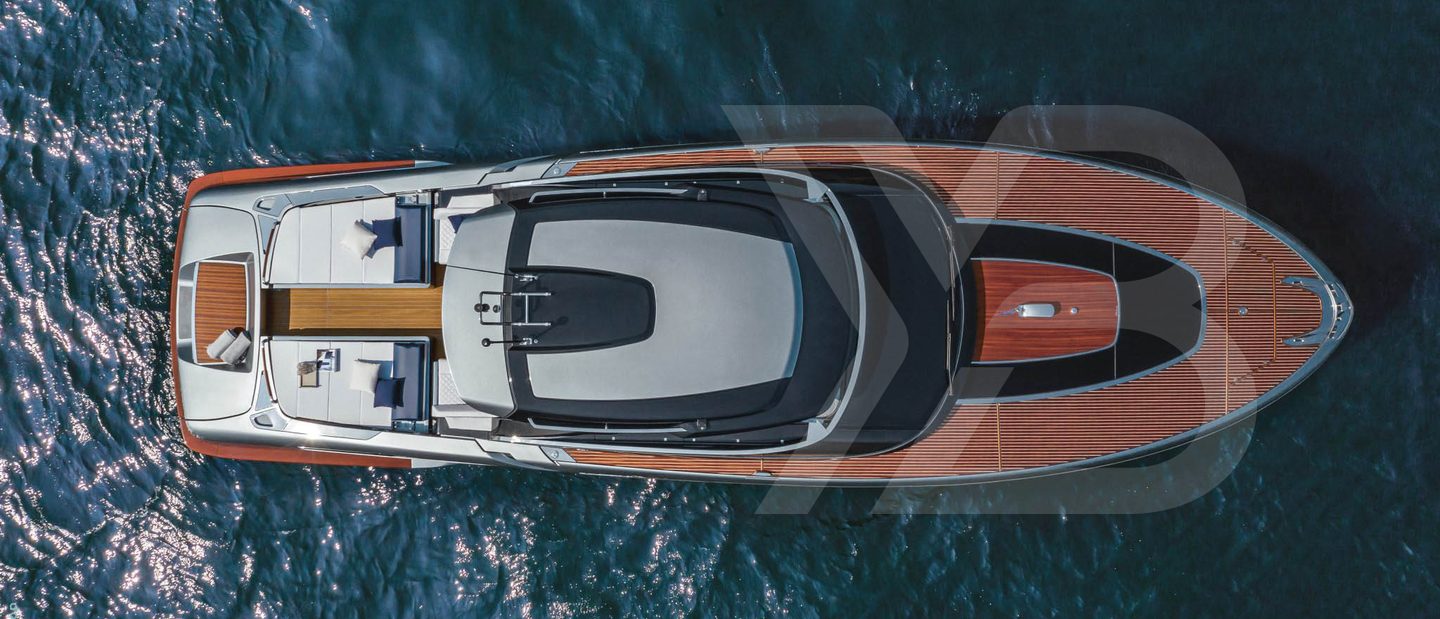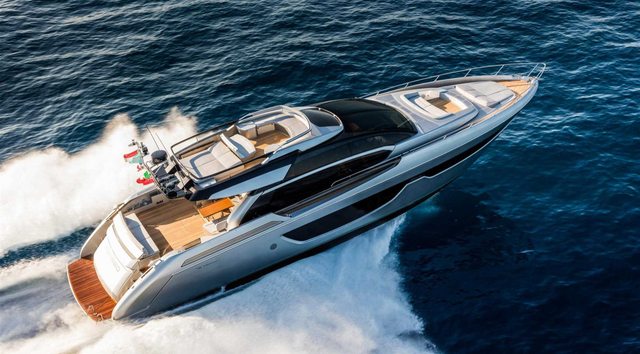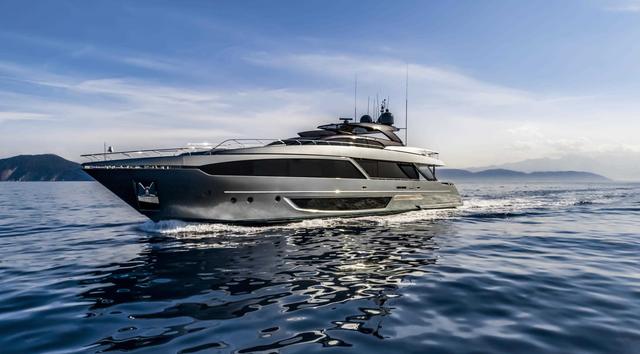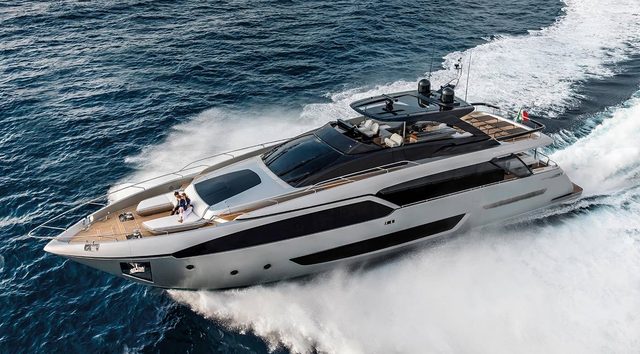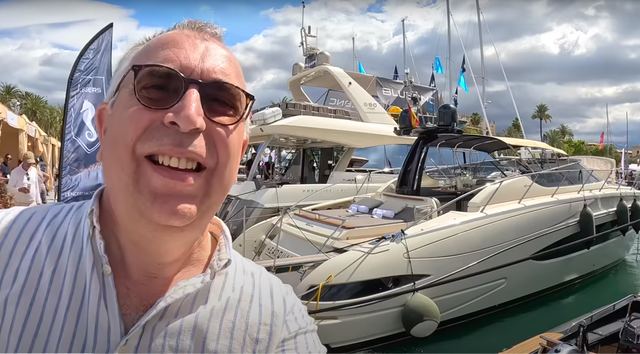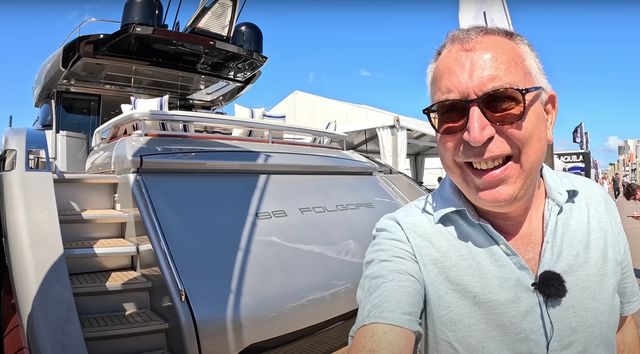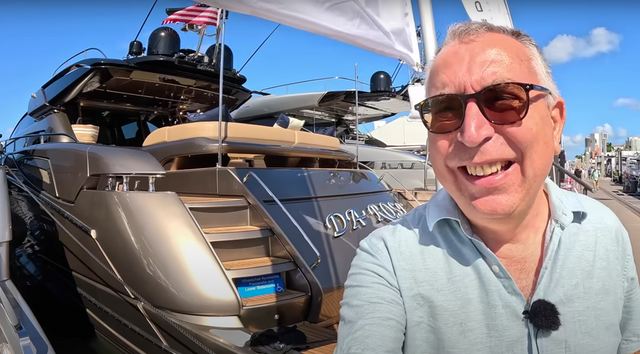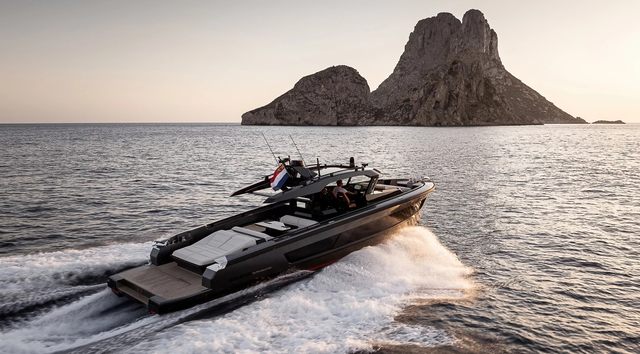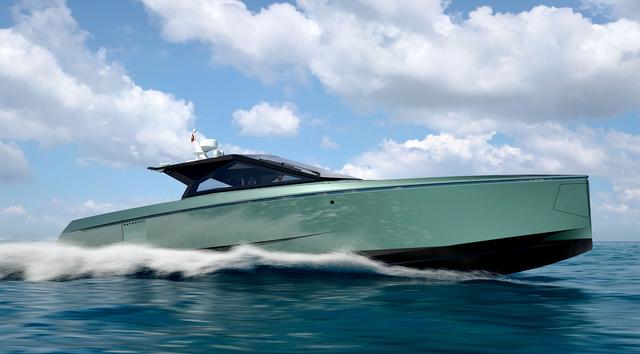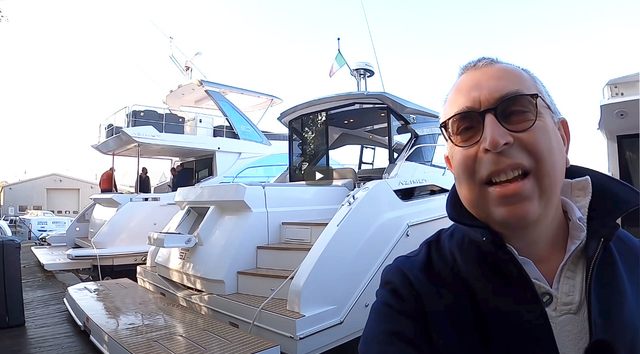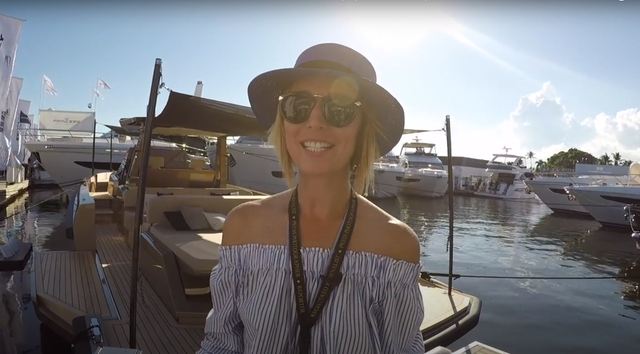You know the Riva name, the polished mahogany, the movie-star glamour. But what if you took all of that and scaled it into something big enough to spend a weekend on, fast enough to hit 40 knots, and still as polished as a piece of fine furniture? That’s where the Dolceriva comes in.
Riva Dolceriva Key Facts

- LOA 14.92m
- Model Year 2023
- Cabins 1
- Max Speed 39 knots
- Status In Production
- Yacht Type Sportsboat
- Use Type Weekending
Review Video
In the Riva family, the Dolceriva lands in a sweet spot at just under 15m. It is bigger than the pure dayboats like the Rivamare but still far more intimate and sport-minded than the larger open yachts. It was also the first to wear a new, sharper-edged design language that now runs through the range.
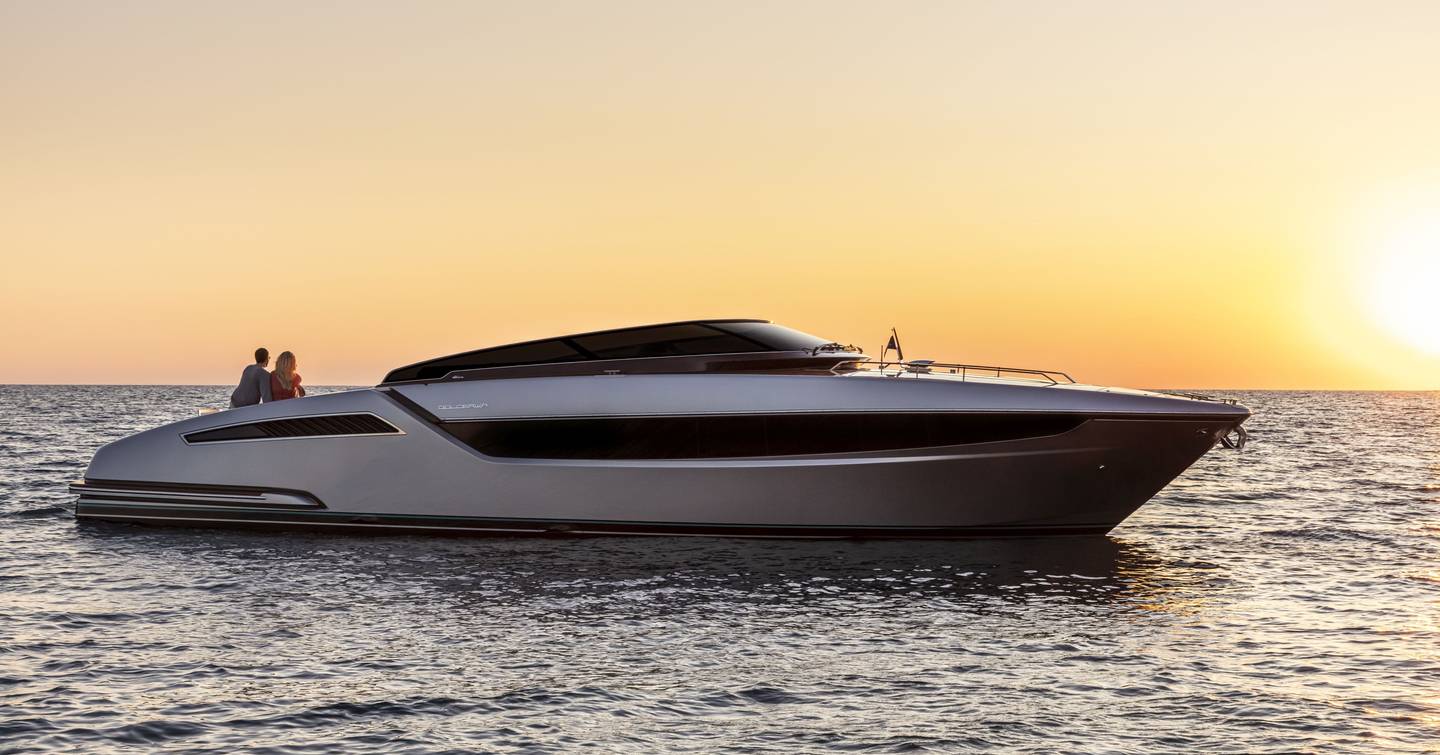
The shape comes from Officina Italiana Design, the studio headed by Mauro Micheli and Sergio Beretta. They have been behind every modern Riva for more than 25 years, working closely with Ferretti Group’s engineers to balance classic detailing with more automotive-inspired touches. That shows in the way the hull window sweeps up towards the deck, the clean hull-deck joint with its carbon-fibre and steel vent, and the gentle curve of the stern that recalls the wooden Ariston and Tritone. The forward deck is exactly what you expect from a Riva - high-gloss mahogany with white maple seams, built up in twenty coats of varnish until it looks like still water.
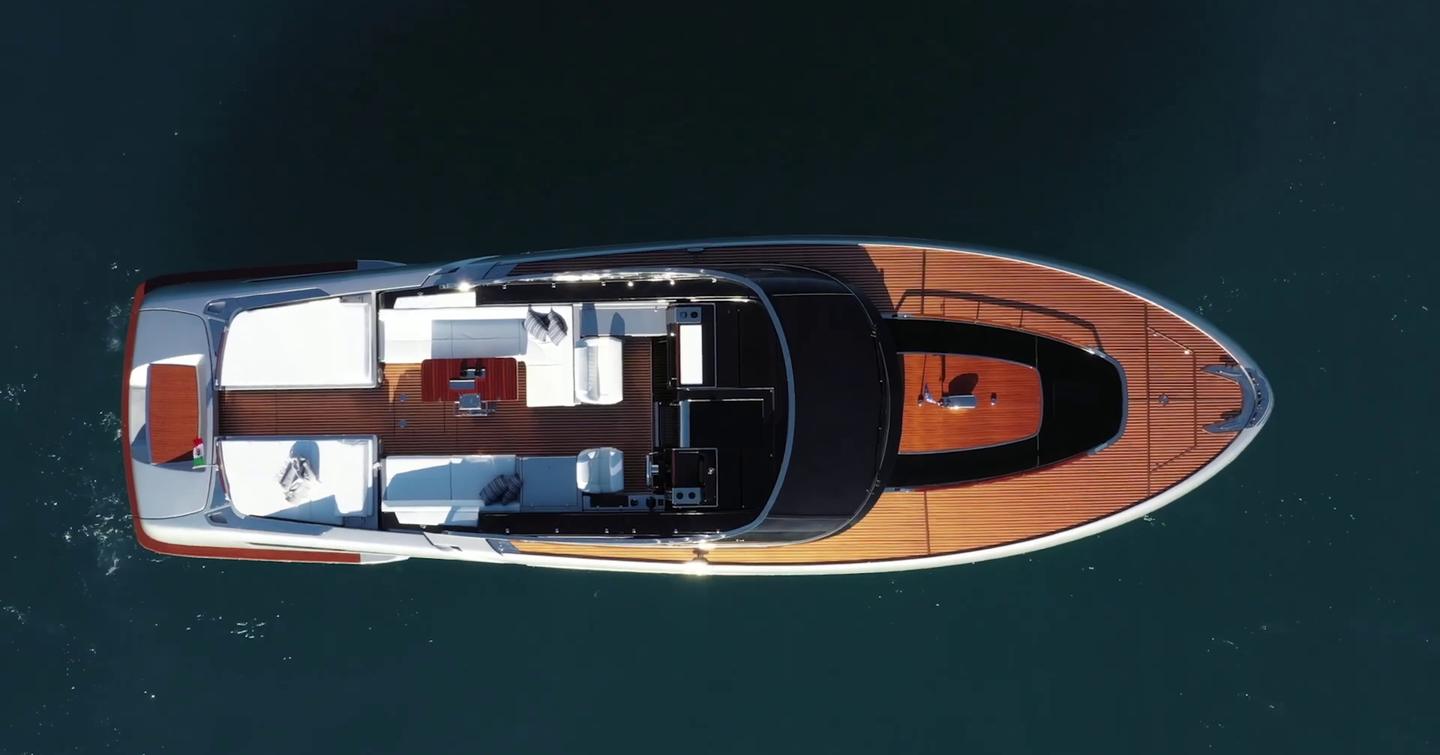
The build mixes a solid composite hull with lightweight carbon-vinyl ester sections where it matters for strength and stiffness. Opt for the carbon-fibre hard top and it sits low over the cockpit, stainless steel worked in for extra rigidity and a bit of visual punch. Side panels can be fitted, and there is even the option of air-conditioning under there, so the boat works in all weathers without losing its open-boat feel.
As ever with Riva, the craft is in the detail: the gloss and paintwork, the stainless fittings, the way moving parts tuck themselves away when not in use. It is built to look timeless and to keep that look for decades, carrying the link between the brand’s mahogany runabouts and its modern composite cruisers.
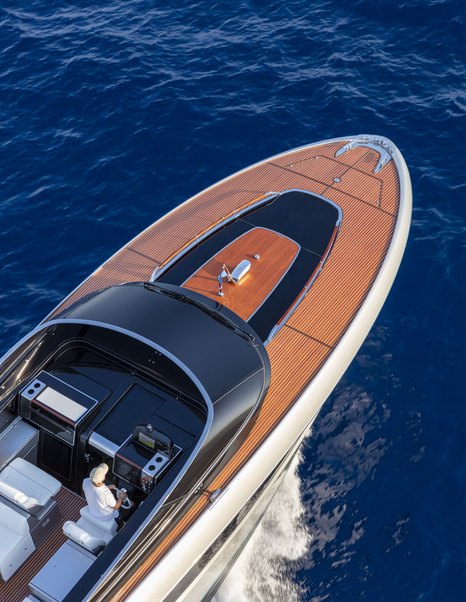

Head below and the Dolceriva immediately feels more spacious than you might expect from a boat that looks like a big day cruiser. It is beautifully put together, of course, but it is also somewhere you could happily escape to when the air-conditioning is running and the sun’s blazing outside.
Instead of a dinette down here, it is laid out as a lounge. There is a long sofa to port with the television mounted opposite, a nice spot to flop down and watch something. In the forward corner there's a compact galley. It is not kitted out for full-on cooking, but it is fine for drinks and snacks, and when it is closed up you hardly notice it is there at all.
The materials are exactly what you expect from Riva (leather, lacquered woodwork, polished metal trim) all finished to the same standard you see on deck. It feels like an extension of the cockpit rather than a separate, shut-away cabin space.
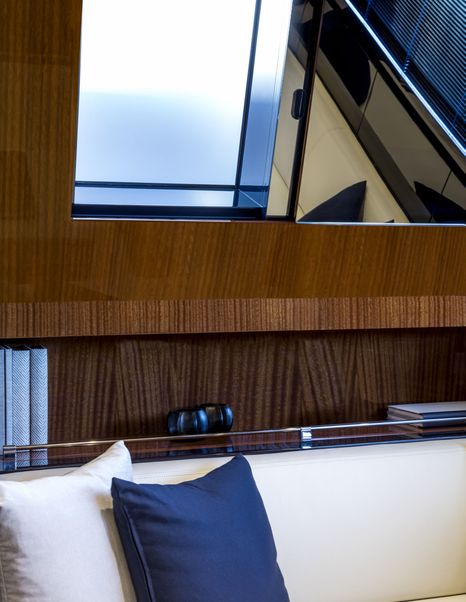
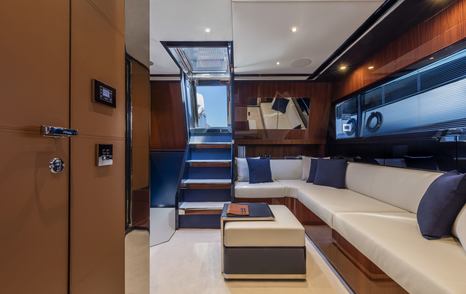
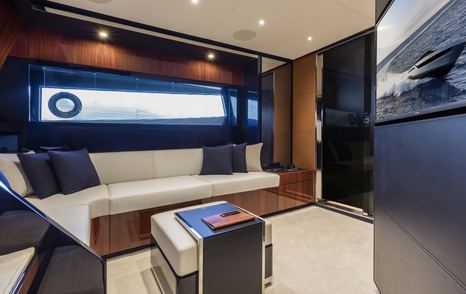
Owner's Cabin
Forward is the owner’s cabin, with a good amount of headroom and a bed set high enough to need a small step either side to climb in. Storage is well thought-out, with cupboards and drawers built into the space, and a skylight overhead that doubles as an escape hatch. It feels bright and airy, helped by the light streaming through that foredeck glazing.
The bathroom sits to starboard and is the only one on board, so it serves both cabins. It is a decent size, with proper standing headroom in the separate shower cubicle. The sliding door looks great and saves a bit of space, and the fit-out is the same high-gloss timber and polished steel you see everywhere else.
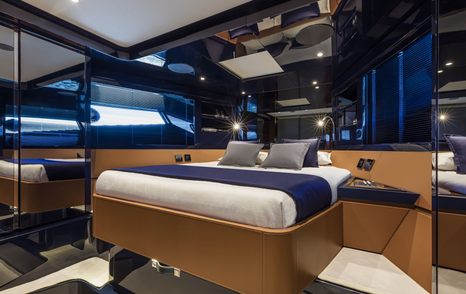
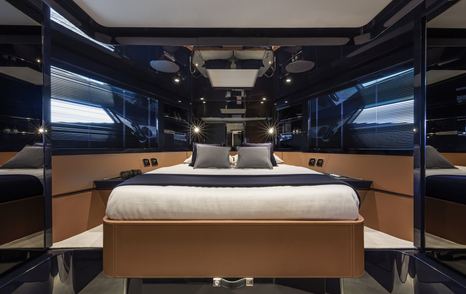

Guest Cabin
Aft, under the cockpit, is the guest cabin. The first thing you notice is the detailing, like on the door handles that have the Riva name etched in, and the thresholds are engraved so the branding greets you as you step through. Headroom just inside the doorway is actually very good, but as you move under the cockpit roof you do have to crouch a little.
The layout is a pair of decent-sized single berths with a full-height hanging locker to one side. The finish matches the rest of the boat so it feels like a proper part of the interior, not a token extra cabin.

You’ve got a single helm chair to starboard and a smaller double seat to port, both finished in a white and green trim. Between them, Riva have tucked in a neat little wet bar - sink on top, a top-loading fridge that drains overboard, and another cooler space underneath. Perfect spot to stash the beers without heading below.
The helm itself is a showpiece. Stainless steel framing, a strip of varnished wood running across the dash, and a wheel that feels weighty in the hands. Visibility down the bow is excellent, and the controls are laid out simply – Volvo Penta throttles to one side, joystick control on the other. Even though this is a shaft-drive boat, the joystick ties in the thrusters with the shafts so you can slide it around in close quarters.
With the bigger Volvo D13s, the Dolceriva will run up to around 40 knots, with a sweet spot somewhere between 30 and 38. Fast enough to feel lively, but very much in keeping with the boat’s grand tourer character.
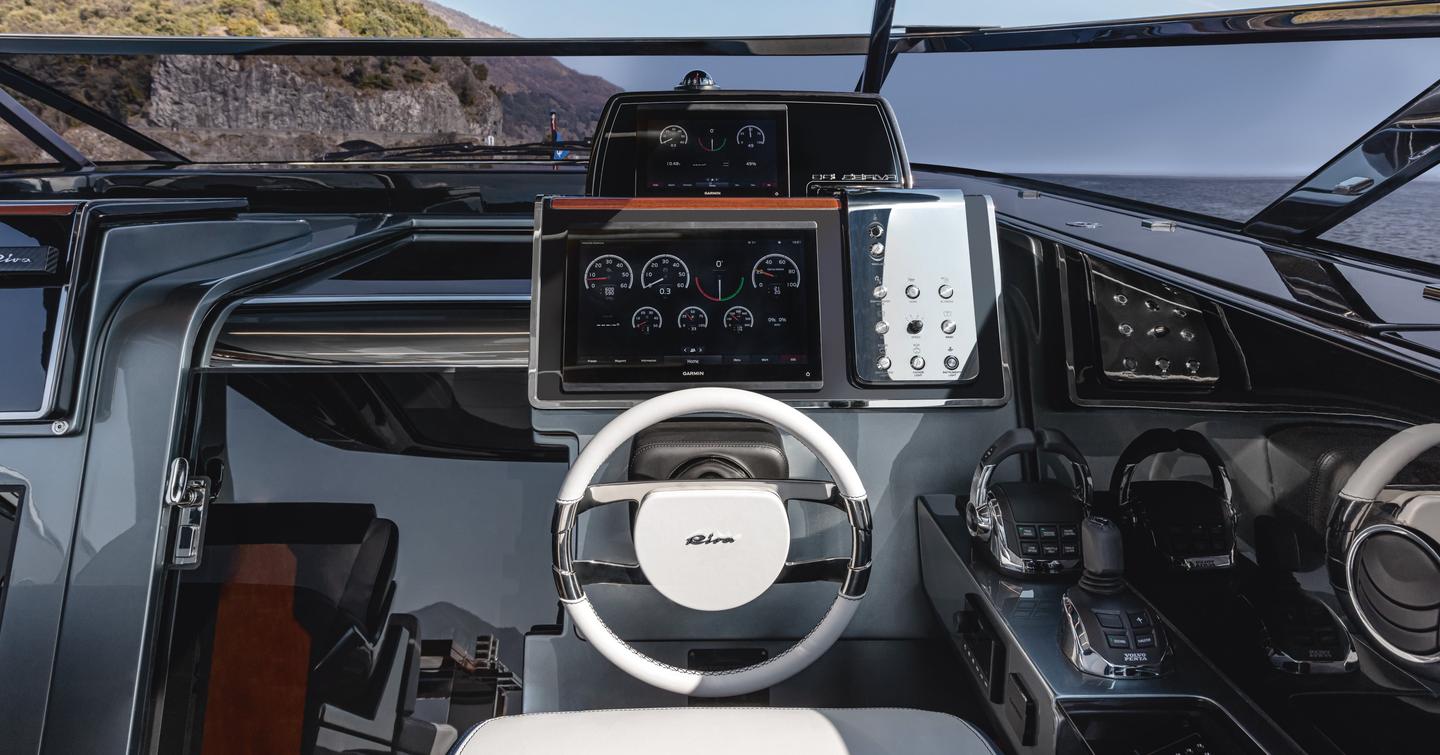
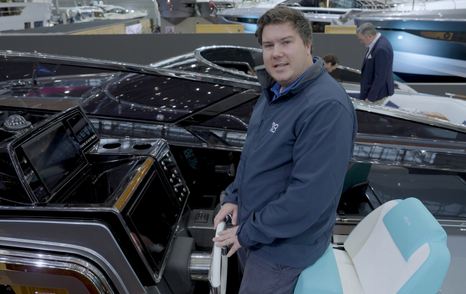
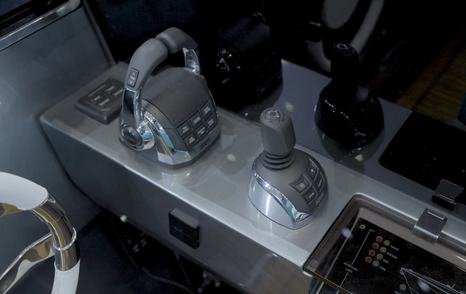
One thing the Dolceriva shares with other modern Rivas is it's folding transom. Drop it down and you get this clamshell effect, with cushions that slot in so it turns into a pair of big sunbeds right on the waterline. Fold it away again and you’re back to that sleek, uninterrupted profile.
Down here the detail is just fantastic. You’ve got varnished wood wrapping around the haunches, stainless capping, even the way the timber runs straight into the stainless on the grab rails. It’s the sort of finish that looks too good to touch, a bit of a fingerprint nightmare - but it still looks superb.
There’s a nice teak walkway up each side, a passerelle that pops out centrally when you’re alongside, and the shore power lives under a solid stainless lid. On the other side there’s the shower, and the fairleads run neatly through to the mooring winches. The little flaps over the cleats are on gas rams too, so you can open them for easier access when you need it.
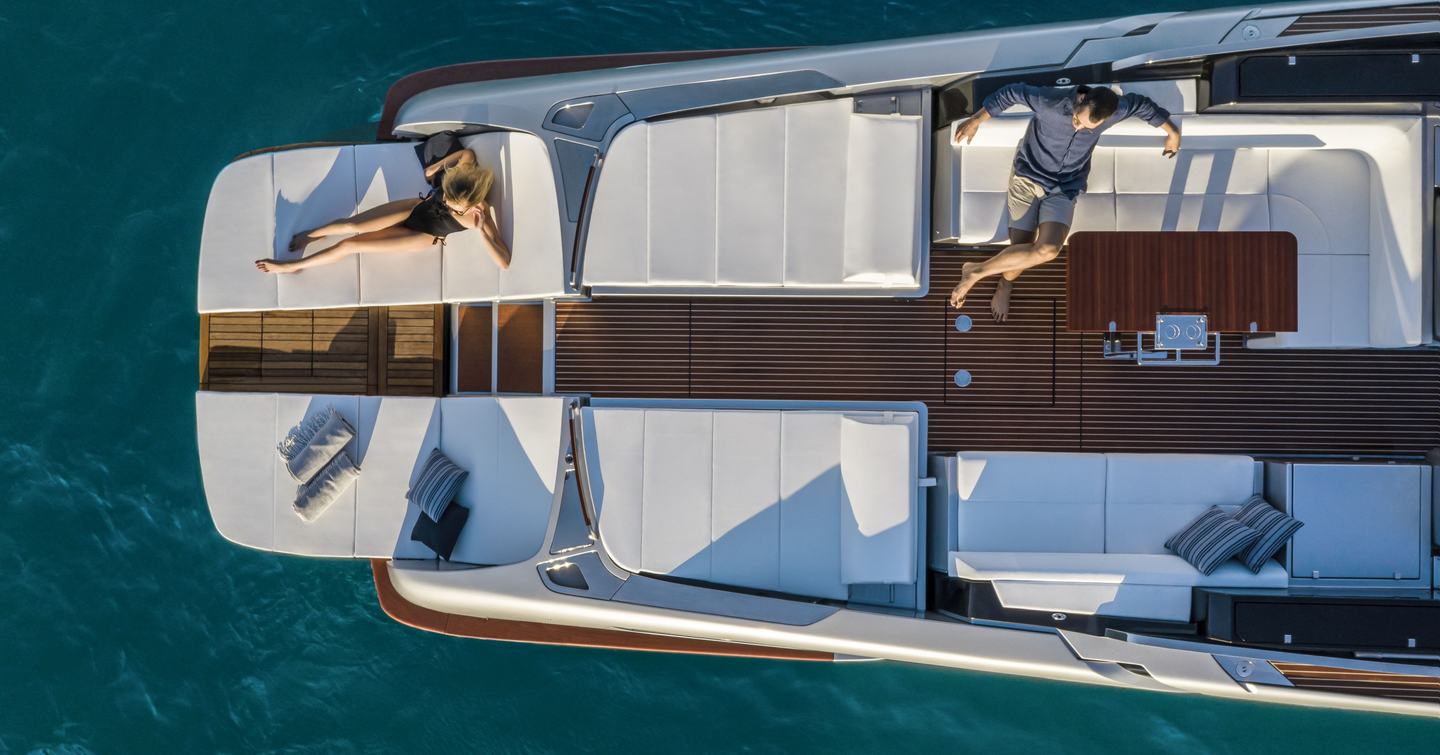
In the cockpit, the first thing that jumps out is the colour scheme - that classic Riva mix, deep hull tones set against white upholstery and plenty of varnished wood. The table here looks almost too perfect to use, but if you do open it up you get a generous dining space. There are finger slots underneath so you’re not putting prints all over the gloss, and because it’s a hefty bit of furniture, those slots make it easier to slide from side to side.
Just ahead, under the counter, is a huge dry storage area. Open the hatch and there’s a proper ladder down into it - a really useful void for keeping bulky gear out of sight. There’s more clever thinking above too. Push a button at the helm and a bimini springs out from a pair of flaps, covering this whole space. We couldn’t put it up indoors here, but it’s there for when the sun gets fierce.
It’s the same mix of polish and practicality as the stern with all the glamour you expect from a Riva, but still somewhere you can settle in for a long lunch.
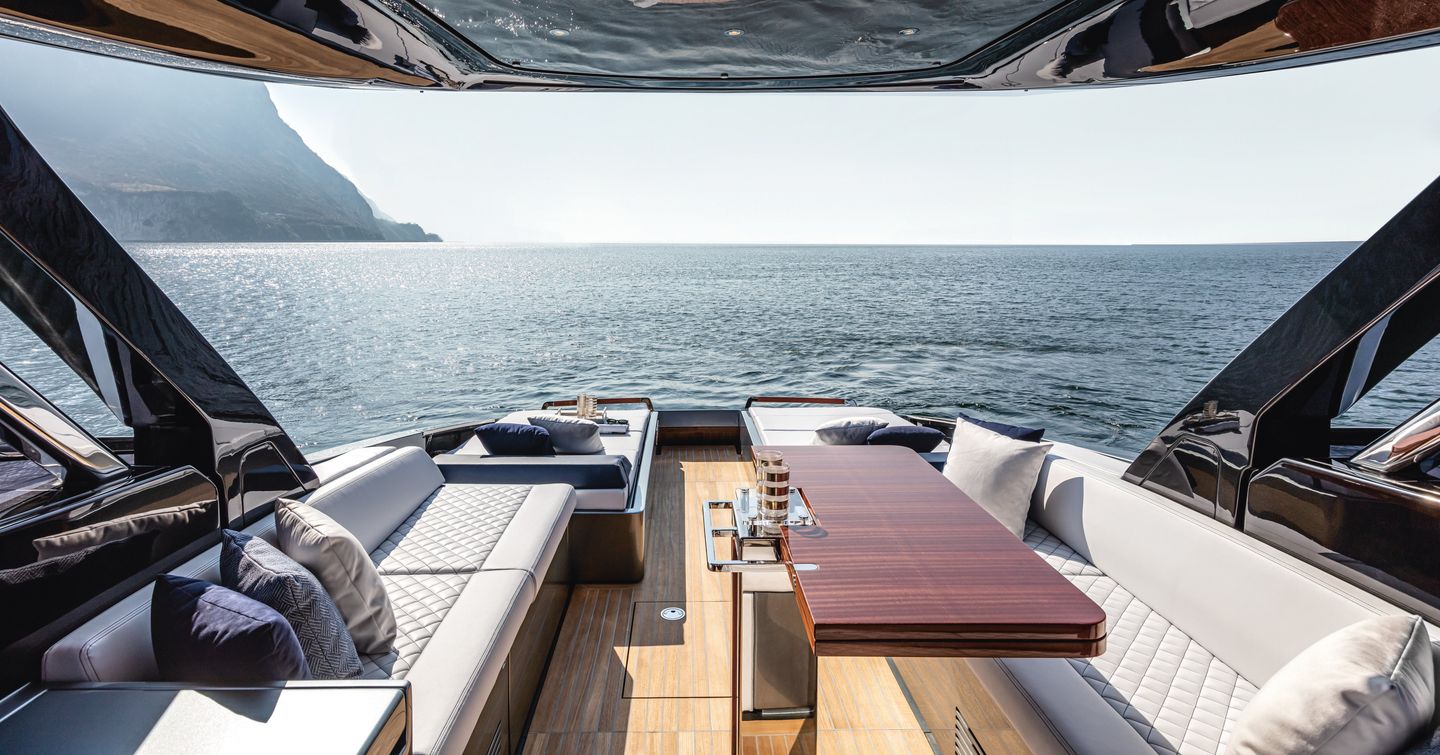
Like a lot of sleek boats, there are a few trade-offs, and one of them is getting to the engines. The hatch in the cockpit is not huge, and once you are down there it is crouching room only. Moving right around the engines is tight, so you would not want to be doing major work in there without some patience.
This boat runs on a pair of Volvo Penta D13 diesels, either the 800hp standard engines or the 1,000hp option. The bigger set will push it to around 40 knots, with an easy 30-38 knot cruising range. Even with the 800s, it still has that grand-tourer pace and a relaxed, solid ride. Power goes through V-drive shafts to conventional props, so it feels like a proper inboard to drive. Joystick control is on the options list, tying the shafts to the bow thruster for those neat little sideways moves when you are docking.
Down here you will also find the interceptor trim system, the optional Seakeeper NG6 stabiliser if it has been fitted, and a 7kW generator. It is all neatly installed, with the same tidy wiring and pipework you would expect from Riva, but it is not the sort of space you go into for fun.

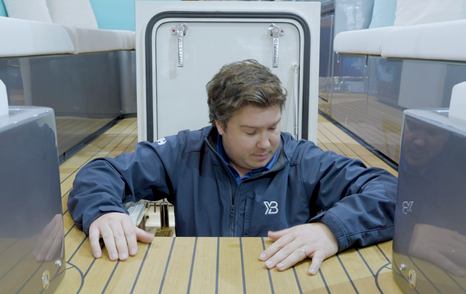
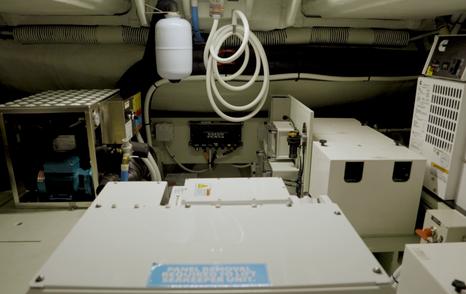
Our Verdict
The Dolceriva is very much a modern Riva – full of beautiful detailing, clever touches and the sort of finish that makes you stop and look twice. It is as happy cruising fast as it is sitting quietly at anchor, and while there are a couple of compromises in space and access, they feel like part of the trade for such sleek lines. For anyone who wants the glamour of a classic Riva in a package that works as a stylish weekender, it is a tempting mix.
Reasons to Buy
- Timeless Riva styling and detailing
- 40 knot top speed
- Hidden deck fittings
Things to Consider
- Tight engine room access
- Slightly awkward foredeck access
Looking to own a Riva Dolceriva? Use YachtBuyer’s Market Watch to compare all new and used Riva Dolceriva Boats for sale worldwide. You can also order a new Riva Dolceriva, customized to your exact specifications, with options for engine choice and layout configuration. Alternatively, explore our global listings of new and used boats for sale and find your perfect boat today!
Rivals to Consider
Against the Stratos Dutch Built 50, the Dolceriva feels a little more about glamour than grit. The Stratos is built like a pilot boat in a tuxedo with heavy-duty structure, carbon-fibre superstructure, and engineering that looks like it came from a superyacht engine room. It also claims space for up to four guests from a single cabin layout, which is a neat trick. Performance is solid at around 36 knots with the bigger IPS options, and it will cruise for about 400 nautical miles at 26 knots, so it’s the sort of thing you could point at another coastline without much planning. The Dolceriva can match the pace and adds the option of a second cabin, but its focus is more on that Riva finish and the theatre of arriving somewhere.
The wallypower 50 plays a very different game again. With it's avant-garde profile, the glass-and-carbon dome of a wheelhouse, and fold-out terraces that turn the cockpit into a huge flat deck. In standard IPS form it runs to around 36 knots, but the X version with four outboards will nudge past 50 if you really want to hang on. Accommodation is minimal with one cabin for two people, so it’s more dayboat than weekender, but it does the Wally thing of making everywhere you go feel like an event. The Dolceriva isn’t chasing that kind of radical look; it’s the more classic grand tourer in this company, with the pace to keep up but a style that won’t date.
Considering a new boat? Explore Riva's entire current range to find the model that best suits your needs, and compare it with alternatives from competitors to ensure you make the perfect choice.
Specifications
- Builder Riva
- Range Open
- Model Dolceriva
- Length Overall 14.92m
- Beam 4.26m
- Draft 1.48m
- Hull GRP
- Cabins 1
- Berths 1
- Yacht Type (Primary) Sportsboat
- Use Type (Primary) Weekending
- Cruising Speed
- Max Speed
- Fuel Capacity 1,800 Litres
- Fresh Water Capacity 310 Litres
- Engine Model 2x Volvo Penta D13-1000
- Engine economic speed 16.1 knots
- Engine max range (speed type) 191 (nm)
Interested in a Dolceriva?
NEW Build
Find your local dealer for a personalised, no-cost consultation
or just request
Brochures & Pricing
Used & In Stock
Looking for a ready-to-go Dolceriva or pre-owned options? Explore all inventory of the Dolceriva available worldwide
